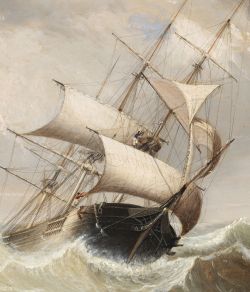loading 
Fitz Henry Lane
HISTORICAL ARCHIVE • CATALOGUE RAISONNÉ • EDUCATIONAL RESOURCE
An online project under the direction of the CAPE ANN MUSEUM
An online project under the direction of the CAPE ANN MUSEUM
Catalog entry
inv. 4
Three Master in Rough Seas
A Ship in a Stormy Sea; A Smart Blow
1856 Oil on canvas 10 1/2 x 15 3/4 in. (26.7 x 40 cm) Frame: H. 22 1/4 x 43.2 in. (56.5 cm) 17 Signed, dated, and inscribed verso: F.H. Lane 1856 A Smart Blow
|
Related Work in the Catalog
Supplementary Images
Provenance (Information known to date; research ongoing.)
the Artist, Gloucester, Mass.
Samuel A. Stacy, Gloucester, Mass., 1895
Harriet S. Stacy, Gloucester, Mass.
George O. Stacy, Gloucester, Mass.
Jane Parker Stacy, Gloucester, Mass., 1928
Cape Ann Museum, Gloucester, Mass., December 1948
Exhibition History
National Gallery of Art, Washington, District of Columbia, Paintings by Fitz Hugh Lane, May 15–September 5, 1988., no. 15, ill. in color, p. 86.
Traveled to: Museum of Fine Arts, Boston, Mass., 5–31, 1988.
Traveled to: Museum of Fine Arts, Boston, Mass., 5–31, 1988.
Published References
Wilmerding, John. Paintings by Fitz Hugh Lane. Washington, DC: National Gallery of Art; in association with Harry N. Abrams, 1988., no. 15, ill. in color, p. 86.
Craig, James. Fitz H. Lane: An Artist's Voyage through Nineteenth-Century America. Charleston, SC: The History Press, 2006., pl. 31, text, p. 27.
Berry, Nancy E. "Digital Arts: The Cape Ann Museum moves 19th-century artist F.H. Lane online and into the 21st century." Northshore Magazine (May/June 2016). ⇒ includes  text
text

Commentary
Ships in distress have always been a favorite subject of marine painters. Besides the visual drama of the clouds, sea, and heaving ships, Lane's painting depicts a situation that could have ended in life or death. Shipwrecks were a very real terror to coastal people, particularly in Gloucester. Dozens of fishermen were lost every year: 162 men were lost in 1862 alone. In a town of only eight thousand people, these losses touched everyone’s life. A painting such as this must have triggered all those fears, yet it is also celebrating the capability of ships and their crews to weather such storms. One imagines a Yankee audience being far more drawn to a scene where skill and shipcraft survive a storm, rather than to the pathos of the common shipwreck painting where all hands are lost.
This is one of Lane’s finest paintings of the genre. Surprisingly small (only 10 x 16 inches), it is a highly detailed, flawlessly composed and painted story of a dramatic moment on a ship in a clearing storm. In the enlargement (below) one can see that the fore-topsail sheet has broken and the bottom is flying free. The starboard fore topsail sheet has parted and the loose corner of the sail is flogging wildly, certain to suffer serious damage if not furled quickly. Two crewmen have been sent aloft to assess the condition of the sail, which must be clewed up (lower corners hauled up to the yard) before they can go further. Out of sight on deck is most of the crew preparing to lower the topsail yard to the mast cap, clew up the topsail, haul up its buntlines, and trim the topsail yard, making the sail less difficult to furl. Then all hands will go aloft to furl the topsail, which will demand all their strength in a coordinated effort. Imagine a sail of several hundred pounds of wet canvas whipping about in a forty-plus-knot wind. The force of the sheet (rope) attached to a sail that is flapping in the wind could easily send a man flying to an instant death. The almost unimaginable feat of corraling and furling a sail in a gale on a wildly pitching ship was an everyday occurrence for seamen of the time.
Unlike the wild imaginings of novelists and land-locked romanticists, seamanship on a large square-rigger required discipline and coordinated actions of the highest order. Nothing was left to chance. Every sailor knew his job and understood his place in every task, for his life – and the lives of his shipmates – depended on it. Acutely conscious of this, Lane was careful in depicting a ship’s crew at sea. As the son of a sailmaker – one of the waterfront’s most respected class of artisans – he would have had rare access and insight to the vessels and the trades which built and operated them.
Lane’s mastery is on full display in this painting. In the enlargement below, note the extraordinary precision of the rigging. The fine, hair-thin lines represent entirely accurately how this ship would have been rigged. The masts and yard arms show all their proper variation in color and size; the sails show their weight and texture and the force of the wind. The hull is a dark monolith forging through the waves. One feels that it is at the edge of its equilibrium; it is a match for these seas, but only just. Lane has positioned the hull rising in the seas, setting the angle of the vessel’s pitch and its masts at a perfect diagonal. One anticipates how the bow will come crashing down and how the hull will pitch in the opposite direction as it takes the next wave.
This is a dynamic composition that Lane has further focused by framing it with the dark shadows of the waves on the lower left and right, mirrored by the dark clouds in the upper left and right. The sky has some soft pink in the clearing center and on the horizon. The overall palette is green, dark umber, and pink: a deceptively simple and sophisticated color scheme.
– Sam Holdsworth, Erik Ronnberg